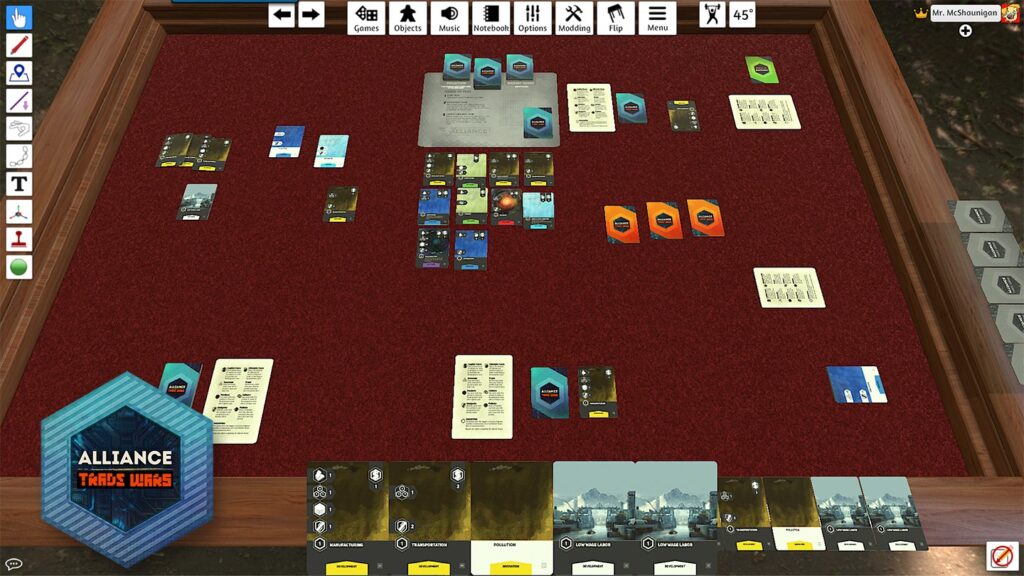Are you getting tired of teleconferencing? Would you like more actual interaction with your human interactions during this time of isolation?
I have been testing my educational card games and board games with students from all over the world on Friday nights through an app called TableTop Simulator, and we find it’s so much better than a typical zoom call or video conferencing. Here’s 5 reasons why.
1. TableTop Simulator Lets You Fidget
TableTop Simulator is a virtual 3D space with a very tactile feel far different from both plain old teleconferencing and also very different from the typical online game environment. You may have tried to play a card game or board game over the internet in which card moves are restricted by the rules. This is not that.
Tabletop Simulator puts you at a 3D table and lets you pick up, throw, flip, roll, shuffle, any and every object. You can even flip the table! You can write on or draw on the table. You can literally play and fidget with anything and everything while waiting for your turn.
It’s difficult to explain how dramatically this improves meeting online. It feels so much more human to be able to point out, interact with, and fidget with shared objects in 3D space. Though it is still a virtual 3D space, at least it puts you all in the same space at the same table.
2. True Equanimity: Card Games & Board Games Make You Take Turns
Not only will everyone be interested in participating but these games systematically facilitate how much influence and time each person gets to exert in short intervals. Everyone truly has equal weight at the table. And the more you pay attention during other players’ turns, the more opportunities it will give you to determine who wins, who influences who, and how to take advantage.
Card games facilitate interactions from each and every participant.
No matter how many people are in a virtual meeting, only one person is really ever active for 90% of the time. At worst, and most often, one person does 90% of the talking while everyone else is a passive observer. Personally, if I’m just going to passively observe then I’d rather watch Netflix.
And even in the unlikely event that the meeting is extremely well organized and facilitated by one person willing to do the necessary preparation to give participants a real chance to actively participate, no more than the facilitator and a couple stakeholders will likely volunteer.
Games make it so that even the quietest most passive participant will have an active role in how the event unfolds. They will have to make at least a few critical choices, and you can read a lot into their character by analyzing those choices.
Games Give Everyone Skin in the Game
In a card game or board game everyone has nearly equal influence and an invested stake in how the event will unfold. Everyone is given critical decisions, both big and small, that will constantly change the flow of information. Who will win and who will destroy who? This mystery hangs over every participant’s head like the sword of Damacles and every player feels like the main character investigating their enemy’s plot.
- No Bad Blood Even if You Choose to Be the Bad Guy
Games allow you to take risks, be mean, and bully each other without punishment or repercussions. You might be given a role to play randomly, or you may choose to be the bad guy, but it’s all just role play, so no one seriously gets hurt even if you are publicly backstabbing one another. It all just becomes part of the shared story experience. One you will hopefully be talking about with a smile on your face long after the game ends.
Role-playing is very therapeutic and allows coworkers to release tension. I once brought a game I designed to an English-as-second-language lesson I was teaching at a Korean conglomerate’s engineering department. During the first class the head of the department played the game and had a great time learning English with his employees. The second group was waiting outside the meeting room with eager anticipation after hearing all the laughter and commotion coming from inside the room during the first group’s lesson. As soon as they entered and closed the door behind them they asked me, “What was going on? We have NEVER heard our supervisor laugh!”
- Everyone Loves to Gamble – Games bring an Element of Randability.
Dice rolling and shuffling make it so that everyone at the table has a chance of winning and everyone has equal opportunity to influence how the ending will build up and pay off. Some games rely on skill, but the key thing is no one truly knows what will happen in the end, but everyone has a chance to come out on top.
Most of us are only familiar with the top three or four most popular board games like Monopoly, Risk, and classic games like Chess or Checkers. Some are more familiar with card games or party games. But what a lot of people are only just learning is that there is an entire world of designer board games that are designed for adults and are so much more fun and diabolical!
If you are new to designer board games then be sure to read my post in which I share my Top Three Designer Board Games for Newbies.
- It’s Stupid Cheap
I warn you I must rant. Why are we so willing to pay decent prices for physical things and so cheap when it comes to virtual experiences? Ok I guess there are valid reasons why, but there’s no reason why we shouldn’t pay a little if it allows us access to a great experience.
TableTop Simulator costs a one time fee of about $20 USD which you pay on Steam, the online computer game marketplace. But that gives you access to nearly every popular board game on the market for no additional cost!
Keep in mind that one small box card game will typically cost $12 to $20. That’s just one game, but for the same price you get virtual access to most games, including all those $12-$20 games on the Barnes & Nobles book shelf. A designer board game usually costs me at least $40. The same game costs me nothing to play virtually after I’ve paid the initial cost for TableTop Simulator.
It also allows me to play my own custom-made games I’ve designed for the classroom. I have games in development that we game test virtually because it’s so much faster than printing and so much easier to implement changes which we constantly do after each play through.
How to Get Started
- First you need to create an account on the computer game market called Steam if you don’t already have an account and then purchase and install TableTop Simulator for a one time fee of $20. This will give you access to nearly every popular board game on the market!
2. You’ll need to got the TableTop Simulator Workshop on Steam to add some games to your library. I recommend starting with some games you already know or learning Coup which is a great easy to learn bluffing game.
3. Thirdly, you’ll need to use a secondary app to teleconference with whoever joins you at the virtual table. Need someone to connect with? We use Discord, both as an online community and to teleconference with each other.
Discord was made for gamers and works nicely with TableTop Simulator. TableTop Simulator even provides an overlay within the app when you are using Discord so that you can see who is talking.
There are some popular Discord servers specifically for playing TableTop Simulator including the, “Official TableTop Simulator “ Discord server and a smaller one specifically for game designers to game test their new games called, “Board Game Play Testing.”
I’m currently developing ALLIANCE Trade Wars (2-5 players) which is a semi-coop deck builder with a little bluffing thrown in that deals with the themes of international economic wars, energy, and sustainability. Introducing games in an educational context can be intimidating, so this is to give teachers/facilitators something easy to bring to the table.
Join me at our group’s virtual Table!
We would love to have some game testers join us to help develop ALLIANCE Trade Wars or any of the other games we play on our weekly game nights. If you are interested simply fill out this form and we’ll send you the invite and updates




